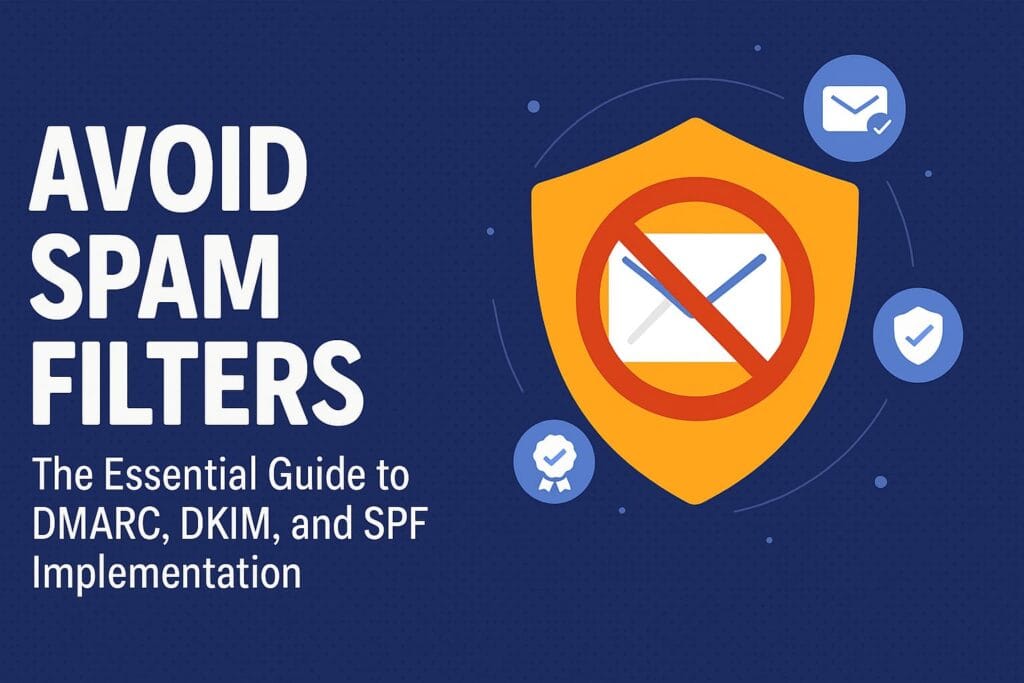Email deliverability is crucial for businesses, marketers, and IT professionals. However, spam filters can block legitimate emails, hurting communication and marketing efforts. To prevent this, implementing DMARC, DKIM, and SPF is essential. These email authentication protocols verify sender legitimacy, improve inbox placement, and protect against phishing. In this guide, we’ll break down how each works, why they matter, and how to set them up correctly to avoid spam filters.
Table of Contents
- Why Email Authentication Matters
- Understanding SPF (Sender Policy Framework)
- How DKIM (DomainKeys Identified Mail) Works
- DMARC (Domain-based Message Authentication, Reporting & Conformance) Explained
- Step-by-Step Implementation Guide
- Common Mistakes to Avoid
- Conclusion
1. Why Email Authentication Matters
Emails are a primary communication tool, but spam filters aggressively block suspicious messages. Without proper authentication, even legitimate emails can land in spam folders. DMARC, DKIM, and SPF act as digital signatures, proving your emails are genuine.
- Improves email deliverability – Ensures emails reach inboxes.
- Prevents spoofing & phishing – Stops scammers from impersonating your domain.
- Builds sender reputation – ISPs (like Gmail, Outlook) trust authenticated senders more.
Without these protocols, your emails risk being marked as spam—hurting marketing campaigns, customer support, and business communications.
2. Understanding SPF (Sender Policy Framework)
SPF is like a guest list for your email server. It specifies which IP addresses are allowed to send emails from your domain.
How SPF Works
- You publish an SPF record in your DNS.
- When an email is sent, the recipient’s server checks if the sender’s IP matches your SPF record.
- If it doesn’t match, the email may be rejected or marked as spam.
Example SPF Record
v=spf1 include:_spf.google.com ~all v=spf1– Defines the SPF version.include:_spf.google.com– Allows Google’s servers to send emails.~all– Soft fail (non-matching IPs are flagged but not always blocked).
Pro Tip: Use -all for a strict policy (hard fail) if you’re confident in your authorized senders.
3. How DKIM (DomainKeys Identified Mail) Works
DKIM adds a digital signature to your emails, verifying they weren’t altered in transit.
How DKIM Works
- A private key signs outgoing emails.
- A matching public key is stored in your DNS.
- The recipient’s server checks the signature against the public key.
Why DKIM Matters
- Prevents tampering – Ensures email content remains unchanged.
- Boosts credibility – ISPs favor DKIM-signed emails.
Example DKIM Record:
v=DKIM1; k=rsa; p=MIGfMA0GCSqGSIb3DQEBAQUAA4GNADCBiQKBgQC... 4. DMARC (Domain-based Message Authentication, Reporting & Conformance) Explained
DMARC ties SPF and DKIM together, telling email providers what to do if authentication fails.
How DMARC Works
- You publish a DMARC policy in DNS.
- Email providers check SPF & DKIM alignment.
- Based on your policy, they deliver, quarantine, or reject unauthenticated emails.
Example DMARC Record
v=DMARC1; p=quarantine; rua=mailto:reports@yourdomain.com p=none– Monitor only (no action).p=quarantine– Sends suspicious emails to spam.p=reject– Blocks unauthenticated emails completely.
Key Benefit: DMARC provides feedback reports, helping you detect spoofing attempts.
5. Step-by-Step Implementation Guide
1. Set Up SPF
- Identify all authorized email servers (e.g., Google Workspace, your hosting provider).
- Add an SPF record to your DNS (e.g., via cPanel or Cloudflare).
2. Configure DKIM
- Generate a DKIM key pair (many email providers offer tools for this).
- Add the public key to your DNS.
3. Deploy DMARC
- Start with
p=noneto monitor traffic. - Gradually move to
p=quarantineorp=rejectonce confident.
4. Test & Monitor
Use tools like:
- MXToolbox (checks SPF/DKIM/DMARC setup).
- Google Postmaster Tools (monitors deliverability).
6. Common Mistakes to Avoid
❌ Multiple SPF Records – Only one SPF record per domain is allowed.
❌ Misconfigured DKIM Keys – Ensure the selector matches your email provider’s requirements.
❌ Skipping DMARC Reports – Regularly review reports to catch issues early.
❌ Using -all Too Soon – Start with ~all to avoid blocking legitimate emails.
7. Conclusion
If you’re looking for professional assistance to implement SPF, DKIM, and DMARC for your domain, feel free to reach out. Our expert team is ready to help you enhance your email security, improve deliverability, and protect your brand reputation effectively.
Avoiding spam filters isn’t just about crafting great emails—it’s about proving they’re legitimate. By implementing SPF, DKIM, and DMARC, you protect your domain, improve deliverability, and build trust with email providers.
Ready to take control of your email security? Start with SPF, add DKIM, then enforce DMARC for full protection. Your inbox placement rates will thank you!
